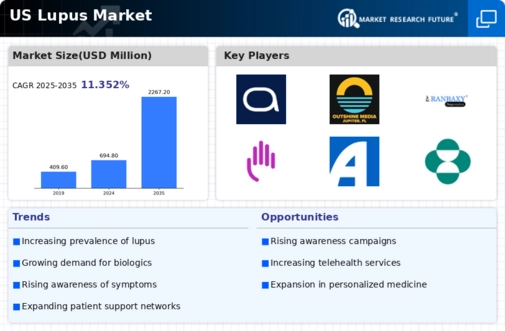Rising Incidence of Lupus
The increasing incidence of lupus in the US is a critical driver for the lupus market. Recent estimates suggest that approximately 1.5 million Americans are living with lupus, with a notable rise in cases among women, particularly those of color. This growing patient population necessitates enhanced healthcare services and treatment options, thereby expanding the market. The lupus market is likely to experience growth as healthcare providers seek to address the needs of this expanding demographic. Furthermore, the rising incidence may lead to increased funding for research and development of new therapies, which could further stimulate market growth.
Innovative Treatment Modalities
The lupus market is significantly influenced by the introduction of innovative treatment modalities. Recent advancements in targeted therapies and biologics have transformed the treatment landscape for lupus patients. For instance, the approval of new biologic agents has provided additional options for managing symptoms and improving quality of life. The market for these therapies is projected to grow, with estimates indicating a potential increase of over 20% in the next five years. This innovation not only enhances patient outcomes but also drives competition among pharmaceutical companies, leading to further advancements in the lupus market.
Government Initiatives and Funding
Government initiatives aimed at improving healthcare access and funding for lupus research play a pivotal role in shaping the lupus market. The US government has allocated substantial resources to support research initiatives, which may lead to the discovery of new treatment options. For example, the National Institutes of Health (NIH) has invested millions in lupus research, fostering innovation and development in the field. Such funding is likely to enhance the understanding of lupus and promote the development of effective therapies, thereby positively impacting the lupus market.
Technological Advancements in Diagnostics
Technological advancements in diagnostic tools are transforming the lupus market. Enhanced diagnostic capabilities, such as improved biomarker identification and genetic testing, allow for earlier and more accurate diagnosis of lupus. This is crucial, as timely diagnosis can lead to better management of the disease and improved patient outcomes. The market for diagnostic tools is expected to expand, with projections indicating a growth rate of approximately 15% over the next few years. As diagnostic technologies continue to evolve, they will likely play a vital role in shaping the future of the lupus market.
Growing Patient Advocacy and Support Groups
The emergence of patient advocacy and support groups has become a significant driver in the lupus market. Organizations dedicated to raising awareness about lupus and supporting patients have gained traction in recent years. These groups not only provide essential resources and education but also advocate for better treatment options and healthcare policies. Their efforts have led to increased visibility of lupus, which may result in higher funding for research and improved patient care. As these organizations continue to grow, they are likely to influence the lupus market positively.
























Leave a Comment